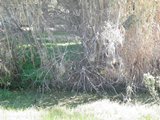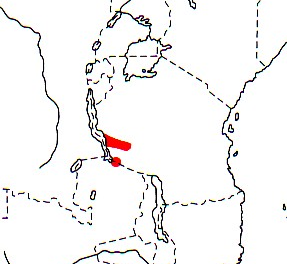Weaver species
Choose different species from drop-down list and press 'Go' button. See Full species list.Tanganyika Masked Weaver Ploceus reichardi
IUCN: Least concern Discovery: 081Categories: wetland,
News items about species
Discovery
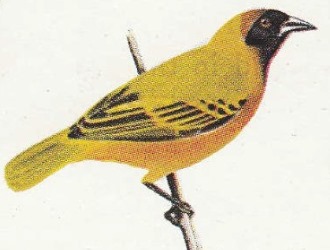
figure from Mackworth (1955) 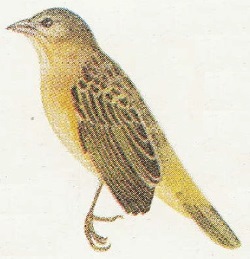
figure from Mackworth (1955) 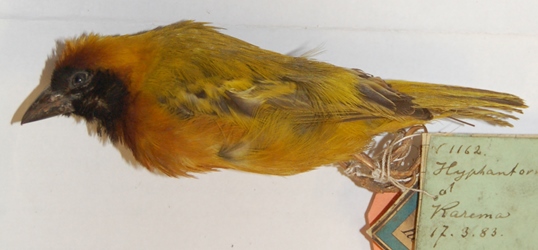
type ZMB_30731 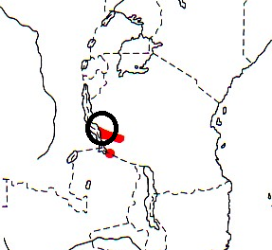
distribution, type locality circled IntroductionThe Tanganyika Masked Weaver was formally described by Anton Reichenow, a German ornithologist and herpetologist.The Tanganyika Masked Weaver was collected by two German explorers, Richard Bohm, and Paul Reichard. In July 1880 Bohm and Reichard, with topographer Edward Kaiser, marched from the port of Bagamoyo into the interior of what is now Tanzania. In November, they founded the Kakoma station and stayed there for nine months. In 1881 Bohm and Reichard explored the Wala River, to the west of Gondo, as far as its mouth. Bohm and Kaiser made a three-month expedition to Lake Tanganyika, returning to the Gondo station at the end of 1881. Later a station was established at Igonda. In October 1882 Eduard Kaiser died on an expedition to Lake Rukwa. In December 1882, Reichard and Bohm left Igonda and traveled to Lake Tanganyika, exploring Karema in Tanzania and Mpala to the west of the lake in the Congo Free State. In March 1883 they found a colony of the Tanganyika Masked Weaver and took some specimens.The nests were in ambatch in knee-deep water. Many nests had 2 chicks, and some had 2 eggs, while other nests were still being built. Some birds and eggs were taken as specimens. The expedition contiued to the DRC where Bohm died of maleria on 27 March 1884. Reichard continued the expedition south to Zambia. He struggled back to the coast, reaching Zanzibar in November 1884. The specimens and notes collected on the 4 year expedition were sent to Berlin, where Reichenow worked through the material and published many new species over the course of a few years. The first illustrations of the Tanganyika Masked Weaver were published by Mackworth (1955), of a male and female on separate plates. Scientific citationPloceus reichardi Reichenow 1886, Zool. Jahrb. pl. 2, p150, Karema, Lake Tanganyika.Meaning of namesreichardi, After Paul Reichard (1845-1938) German engineer, geographer, and collector in East Africa, 1880-1884.First English nameReichard's Vitelline Weaver (Shelley 1905).Alternate namesTanganyika Vitelline Masked Weaver, Tanzania Masked Weaver, Tanzanian Masked Weaver.CollectorRichard Bohm and Paul Reichard.Date collected17 March 1883.Locality collectedKarema am Tanganjikasee = Karema, Lake Tanganyika.Type specimensThere are at least 2 types in the Berlin Museum. |
The above is based on Weaver Wednesday 2, a weekly series about the discovery of each weaver species.
This species text first appeared as
Weaver Wednesday [198] - Discovery [81]: Tanganyika Masked Weaver on 2016-03-30
1. Basic biology

figure from PHOWN 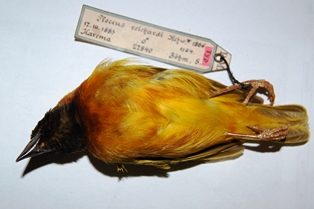
ZMB_27840, showing chestnut wash below The male in breeding plumage is distinguished from Lesser Masked Weaver, Southern Masked Weaver, and Katanga Masked Weaver by the strong chestnut wash on the breast and flanks. It is similar to the Lufira Masked Weaver but the black on top of the head is confined to the forehead, not extending to the hind-crown. The female and non-breeding male Tanganyika Masked Weavers are dull olive above, the breast is orange, the rest of the underparts are dull yellow, with a white belly, and flanks with a dusky brown wash.
Distribution. The Tanganyika Masked Weaver is locally common in Karema, Namanyere and Lake Rukwa in western Tanzania, and it is common along the Saisi River in north-east Zambia (see red on map right). It is monotypic. It has been thought to form a superspecies with other 'masked' weavers, but molecular data suggests that it is only closely related to the Katanga Masked Weaver. Habitat. The Tanganyika Masked Weaver inhabits swamps with papyrus, bulrushes and Phragmites reeds, sometimes far from dry land, and it may forage in woodland. It roosts in swamps. Food.
The diet of the Tanganyika Masked Weaver is mainly grass seeds, and it probably takes termites.
Breeding. The Tanganyika Masked Weaver is probably polygynous. Males are territorial, in colonies of 4-30 nests and sometimes up to 150 nests. The nest is retort-shaped without an entrance tunnel. The nest is tightly woven by the male, using narrow strips of grass blades. A distinct ceiling of grass strips is built. The nest is lined with fine grass panicles and sometimes feathers. The nest is suspended from bushes over water, or attached to grass or reed stalks. The clutch is 2-3 eggs, and the eggs are either bluish with dark brown spots or greyish-olive with diffuse darker markings. Incubation and nestling periods are unknown. Some colonies in bushes were accidentally destroyed by feeding elephants. Nestlings have been collected for food by local people. |
The above is based on Weaver Wednesday, a weekly series about weaver species.
This species text first appeared as
Weaver Wednesday [72]: Tanganyika Masked Weaver on 2013-10-30
2. Breeding facts
| Pair bond Probably polygynous Breeding season Apr in Tanzania; pobably Dec in Zambia Nest site suspended from bushes over water, or attached at side to single grass or reed stalks, 1.5-3 m above ground or water level Nest building woven by male Colony size Males territorial, in colonies with up to 150 nests Clutch size 2-3 eggs Egg colour either bluish with dark brown spots or greyish-olive with diffuse darker markings Egg size average size of seven eggs 20.4 x 13.8 mm (Tanzania) Incubation no information Chicks and nestling period no information |
Breeding information based on Handbook of the Birds of the World, Vol. 15.
3. Photos of Weaver Nests
 Vm 19397 |  Vm 1900 |
Thumb-nails of most recent PHOWN records - click on one to see its full record
See all PHOWN records for this species here.
PHOWN (Photos of Weaver Nests) provides valuable info on breeding distribution and colony sizes of weavers.
You can contribute by registering and submitting photos at Virtual Museum webpage.
4. Breeding distribution
Google map showing distribution (For species with small ranges you need to zoom in at the correct area to see the range):
yellow blob - range of weaver species; read more about this here.
![]() - PHOWN records with photos
- PHOWN records with photos
![]() - PHOWN records with no photos (Nest Record Cards, other records)
- PHOWN records with no photos (Nest Record Cards, other records)
![]() - Birdpix records
- Birdpix records
![]() - comments on out of range records, or interesting records
- comments on out of range records, or interesting records
![]() - type locality
- type locality
CLICK on the marker on the map to see individual record details.
5. Range changes
Not South African speciesThe above is based on Weaver Wednesday 3, a weekly series about range changes in South African weaver species.
This species text first appeared as
n/a








